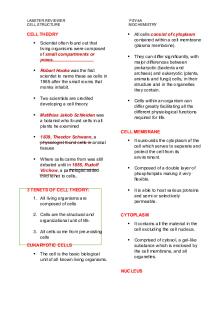Lab 10 - Cell Structure and Function-1 PDF

| Title | Lab 10 - Cell Structure and Function-1 |
|---|---|
| Author | Tristan Ayers |
| Course | Introduction to Biology |
| Institution | Laney College |
| Pages | 2 |
| File Size | 169.3 KB |
| File Type | |
| Total Downloads | 77 |
| Total Views | 163 |
Summary
Download Lab 10 - Cell Structure and Function-1 PDF
Description
Lab 10 – Cell Structure and Function
September 16, 2020
Pre-Lab Questions: 1.) Similarities – both eukaryotic and prokaryotic cells contain ribosomes, cytoplasm’s, and cell membranes Differences – eukaryotic cells contain more organelles and functions, prokaryotic cells don’t contain a nucleus, prokaryotic cells have a different arrangement of genes on the chromosome 2.) DNA in a prokaryotic cell – exists in the cytoplasm because it doesn’t contain a nucleus DNA in a eukaryotic cell – exists in the nucleus 3.) Cell membrane, cell wall, and cytoskeleton Experiment 1: Identifying Cell Structures Post-Lab Questions: 1a.) Chromosomes b.) Nucleus c.) Cytoplasm d.) Cell Wall 2.) Difference – rough endoplasmic reticulum is known for storing only proteins and is found near the cell membrane while smooth endoplasmic reticulum is known for storing proteins and lipids and is found near the cytoplasm 3.) An animal cell would not be able to survive without the mitochondria because the cell would not be able to convert food into energy 4.) A specimen with a cell wall and no nucleus or mitochondria would be considered a prokaryotic cell 5.) Leaves are green because they generate sunlight into energy because they have chlorophyll. Roots are not green because they are underground and do not have to generate sunlight into energy, therefore they do not need chlorophyll Experiment 2: Create A Cell Post-Lab Questions: 1.) Chloroplast and a cell wall 2.) Yes; a plant cell contains a cell wall and chloroplast whereas an animal cell does not 3.) Cilia and cytoplasm 4.) They have certain functions to support the way a cell lives 5.) Cell wall surrounds the cell - supports/protects the cell Nucleus is in the center of the cell – provides “power” to the rest of the cell Chloroplast is located near the edge of the cell – collects sunlight to convert to energy
Plant Cell
Animal Cell...
Similar Free PDFs

Cell Structure and Magnification PPQ
- 28 Pages

Cell Structure SE 1
- 3 Pages

Labster 1 cell structure
- 10 Pages

Cell Structure (reviewer)
- 7 Pages

Structure of generalized cell
- 2 Pages

Cell Structure Worksheet
- 1 Pages
Popular Institutions
- Tinajero National High School - Annex
- Politeknik Caltex Riau
- Yokohama City University
- SGT University
- University of Al-Qadisiyah
- Divine Word College of Vigan
- Techniek College Rotterdam
- Universidade de Santiago
- Universiti Teknologi MARA Cawangan Johor Kampus Pasir Gudang
- Poltekkes Kemenkes Yogyakarta
- Baguio City National High School
- Colegio san marcos
- preparatoria uno
- Centro de Bachillerato Tecnológico Industrial y de Servicios No. 107
- Dalian Maritime University
- Quang Trung Secondary School
- Colegio Tecnológico en Informática
- Corporación Regional de Educación Superior
- Grupo CEDVA
- Dar Al Uloom University
- Centro de Estudios Preuniversitarios de la Universidad Nacional de Ingeniería
- 上智大学
- Aakash International School, Nuna Majara
- San Felipe Neri Catholic School
- Kang Chiao International School - New Taipei City
- Misamis Occidental National High School
- Institución Educativa Escuela Normal Juan Ladrilleros
- Kolehiyo ng Pantukan
- Batanes State College
- Instituto Continental
- Sekolah Menengah Kejuruan Kesehatan Kaltara (Tarakan)
- Colegio de La Inmaculada Concepcion - Cebu









